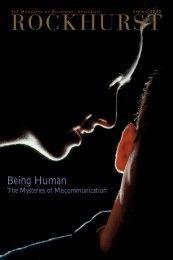in the Jesuit Tradition - Rockhurst University
in the Jesuit Tradition - Rockhurst University
in the Jesuit Tradition - Rockhurst University
You also want an ePaper? Increase the reach of your titles
YUMPU automatically turns print PDFs into web optimized ePapers that Google loves.
Courtesy of The Nelson-Atk<strong>in</strong>s Museum of Art, Kansas City, Mo.(Purchase: Nelson Trust) 47-30Courtesy of The Nelson-Atk<strong>in</strong>s Museum of Art, Kansas City, Mo.(Purchase: Nelson Trust) 55-76Figure 2: Roman, Roman Gentleman, ca. 120, MarbleWe walk all <strong>the</strong> way to <strong>the</strong> opposite(sou<strong>the</strong>rn) side of <strong>the</strong> Nelson gallery to see howmuch we owe to <strong>the</strong> Greeks and Romans. InFigure 3 we see <strong>the</strong> statue of Louis XIV — oneof <strong>the</strong> greatest French k<strong>in</strong>gs (but one who lost alot of battles and put his nation <strong>in</strong>to heavy debtfight<strong>in</strong>g <strong>the</strong>m) — and <strong>in</strong> Figure 4, Benjam<strong>in</strong>Frankl<strong>in</strong>. How do <strong>the</strong> styles of leadership <strong>in</strong><strong>the</strong>se two statues compare to <strong>the</strong> styles communicatedby Hadrian and <strong>the</strong> Roman senator?Louis XIV leads <strong>in</strong> <strong>the</strong> style of Hadrian. Heeven has <strong>the</strong> same Roman armor (and sandals),has <strong>the</strong> same pierc<strong>in</strong>g look of command, and<strong>the</strong> Medusa is even represented <strong>in</strong> <strong>the</strong> statue.Except, now <strong>the</strong> Medusa is on <strong>the</strong> shield overwhich <strong>the</strong> horse is stepp<strong>in</strong>g. Louis <strong>the</strong> XIV vanquishes<strong>the</strong> Medusa, <strong>the</strong> feared non-Christiansymbol. But Louis XIV also legitimizes himselfthrough <strong>the</strong> symbols of fleur-de-lis, whichrem<strong>in</strong>ds a viewer of his royal blood connectionto <strong>the</strong> French Monarchy.And good old Ben Frankl<strong>in</strong> is wear<strong>in</strong>g aRoman toga, just like <strong>the</strong> Roman senator. Hisstatue communicates his democratic leadershipand legitimizes him by connect<strong>in</strong>g him toRoman traditions. He legitimizes himself on<strong>the</strong> basis of his merit <strong>in</strong> persuad<strong>in</strong>g people.But do <strong>the</strong>se models of leadership still applytoday? Today we still argue about differentstyles of leadership <strong>the</strong> Greeks and Romansidentified. Many corporations f<strong>in</strong>d <strong>the</strong>mselvesseek<strong>in</strong>g a more participatory leader after fir<strong>in</strong>ga tyrant, only to replace <strong>the</strong>ir <strong>in</strong>competentparticipatory leader with a new tyrant. But <strong>the</strong>modern leaders may not be learn<strong>in</strong>g much fromhistorical examples of leadership.Figure 4: French, Workshop of Jean Anto<strong>in</strong>e HoudonBust of Benjam<strong>in</strong> Frankl<strong>in</strong>, 1780, MarbleModern leaders don’t often have to askpeople to give up <strong>the</strong>ir lives. Perhaps <strong>the</strong>y can’tmotivate people by appeal<strong>in</strong>g to <strong>the</strong>ir corevalues. Just ask yourself which of <strong>the</strong> corevalues you can use <strong>in</strong> an <strong>in</strong>terview to determ<strong>in</strong>eif you will hire someone. Can you use religion(or place <strong>in</strong> <strong>the</strong> afterlife), family situation,community, patriotism, ideology, image(or gender or race) or wealth and possessions?Modern leaders can’t explicitly or legally useany of <strong>the</strong>se criteria <strong>in</strong> hir<strong>in</strong>g, fir<strong>in</strong>g, retir<strong>in</strong>g,promot<strong>in</strong>g or motivat<strong>in</strong>g people.Or can <strong>the</strong>y? As you walk through <strong>the</strong>museum, th<strong>in</strong>k about how leaders communicatewith <strong>the</strong>ir followers today — through <strong>the</strong> Internet,<strong>the</strong> pr<strong>in</strong>t media and television. How well do<strong>the</strong>se media replace art <strong>in</strong> connect<strong>in</strong>g people tocore values? Or do <strong>the</strong>se modern, efficientmeans of communication tend to elim<strong>in</strong>atereferences to core values? As you walk through<strong>the</strong> galleries, try to recall a case of failedleadership and th<strong>in</strong>k about <strong>the</strong> way <strong>the</strong> failedleader communicated about core values. Werethose values actually communicated? Now th<strong>in</strong>kabout your own leadership roles <strong>in</strong> family orcommunity. Can you create just one way toconnect your leadership with <strong>the</strong> core values ofsomeone whom you wish to lead? Now lookaga<strong>in</strong> at <strong>the</strong> statues of Hadrian, <strong>the</strong> Romansenator, Louis XIV and Ben Frankl<strong>in</strong>. How<strong>in</strong>spired and creative <strong>the</strong> sculptorswere who communicatedleadership through <strong>the</strong>ir art. * This tour of <strong>the</strong> Nelson-Atk<strong>in</strong>s Museumof Art was developed with Sherry Best,director of <strong>the</strong> Greenlease Gallery, although<strong>the</strong> errors <strong>in</strong> this work are all m<strong>in</strong>e.Michael Tansey, Ph.D.23 FALL 2001
















